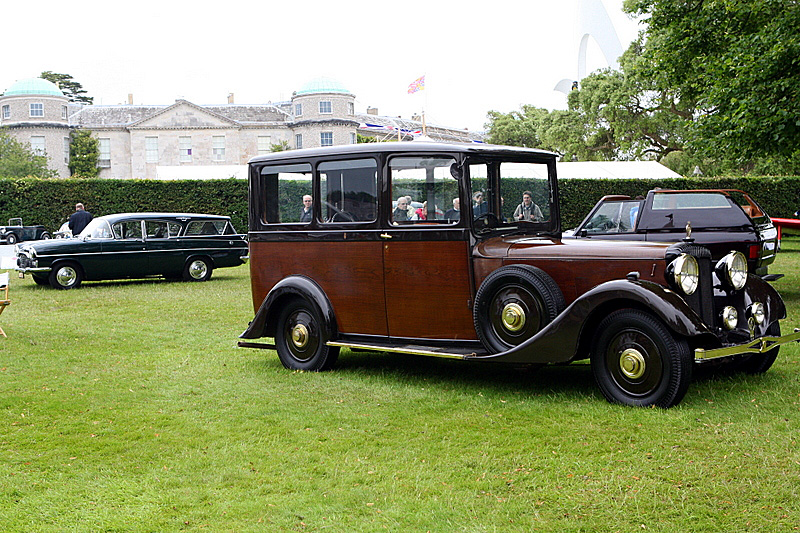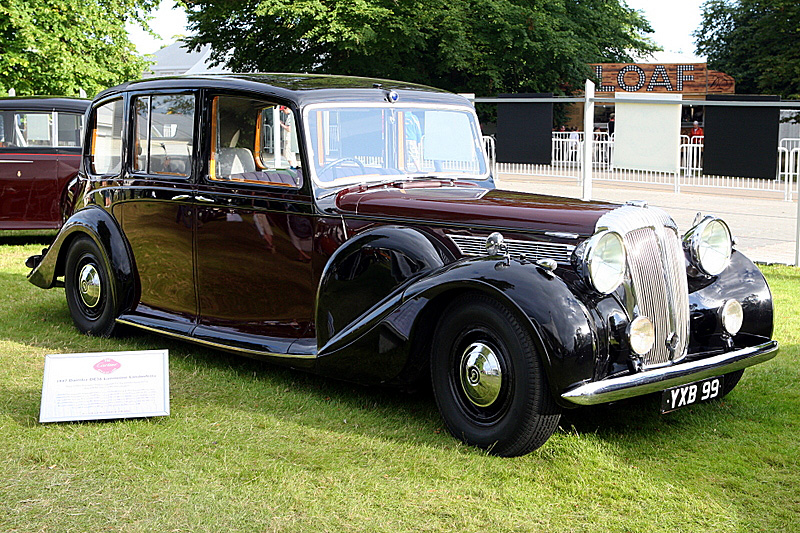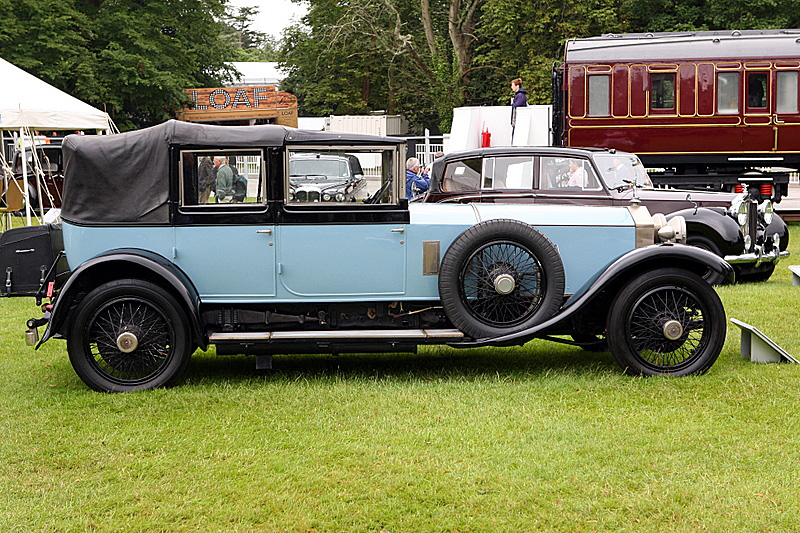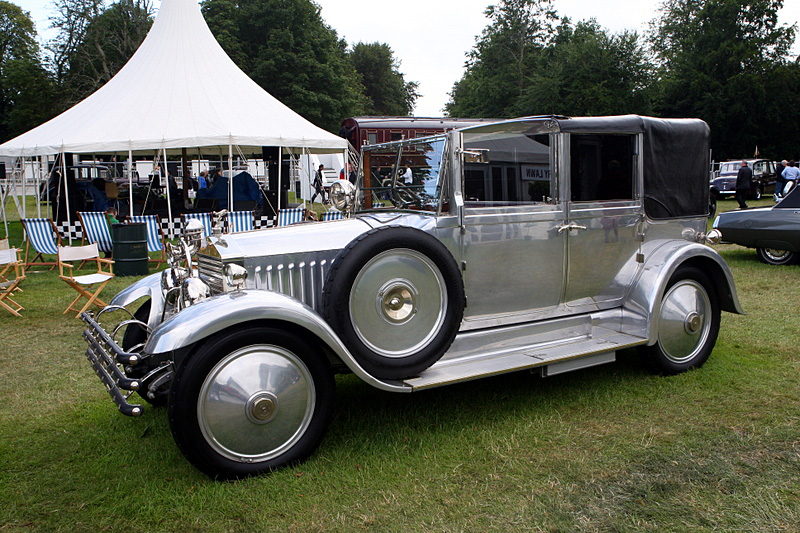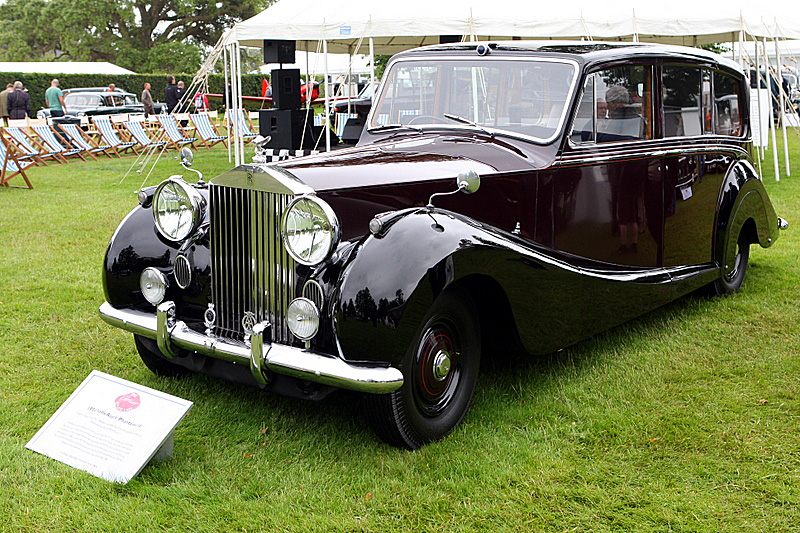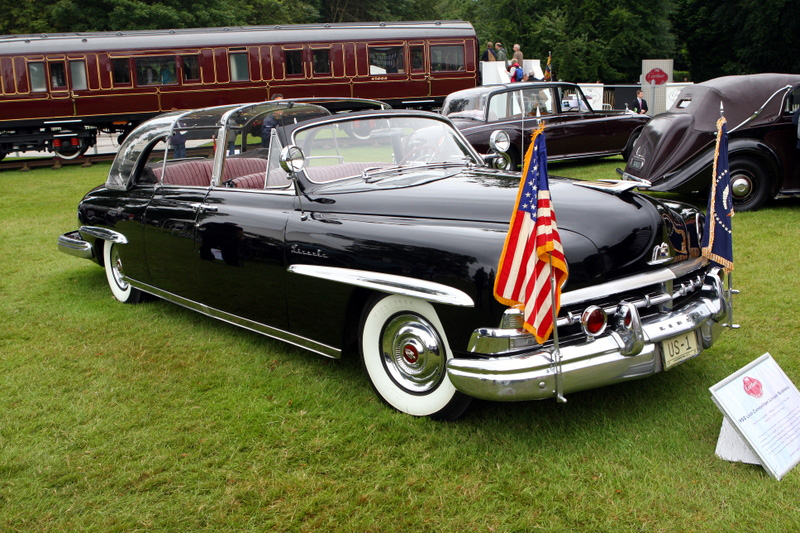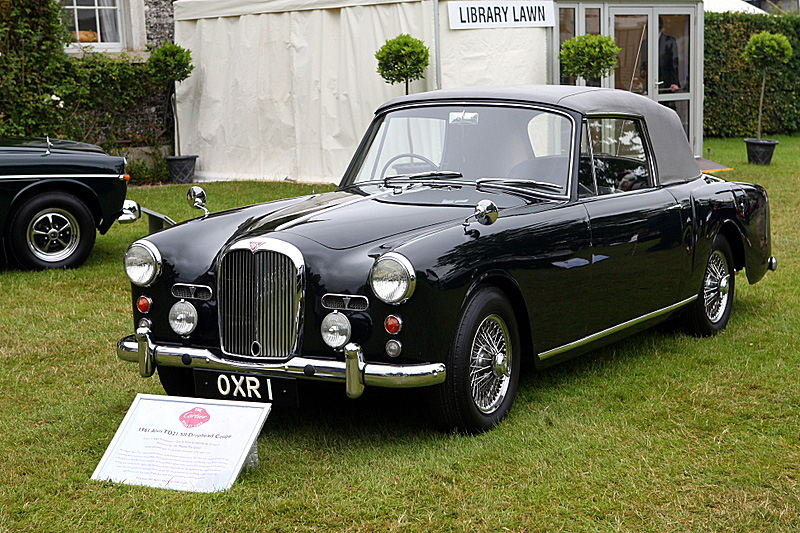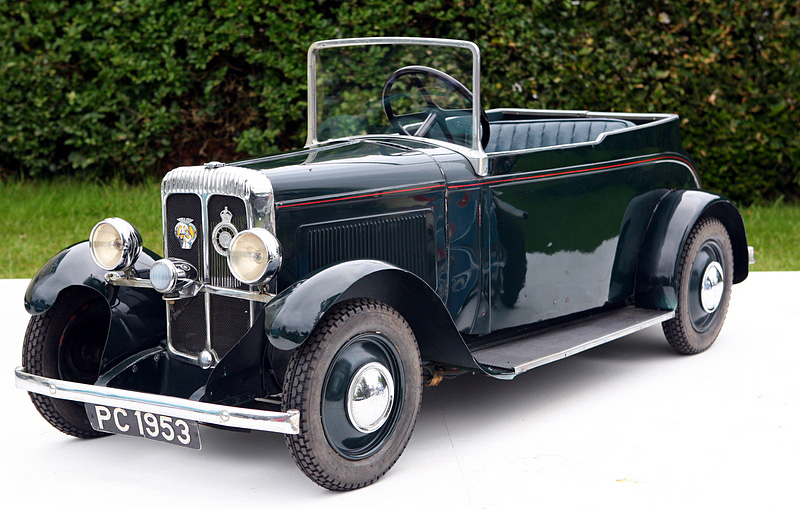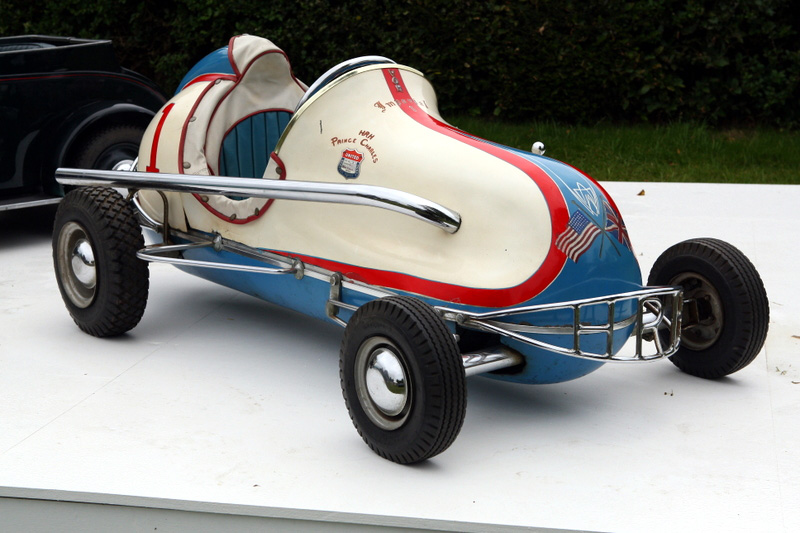Story and photos by Jonathan Sharp
The UK has just celebrated another Jubilee for the Queen. But ten years ago, Jonathan Sharp was also on hand to celebrate a very special event at Goodwood’s Festival of Speed – a motoring tribute to compliment Queen Elizabeth’s Diamond Jubilee held in 2012. It seemed like an appropriate time to republish the account, Jonathan’s first for VeloceToday.com. Congratulations to both the Queen and Mr. Sharp! [Ed.]
This being Her Majesty Queen Elizabeth II’s Diamond Jubilee, the theme chosen for this year’s Cartier “Style et Luxe” display at the Goodwood Festival of Speed was “Transport fit for a Queen”. The display featured cars that were either owned by or used by the Queen or other members of the Royal Family. The display also featured a Royal Train Carriage, children’s electric ride in toy cars and even an aeroplane. The displays, in five classes, were arranged on the grass in front of the stable yard of Goodwood House.
Daimler
In modern times, the British Monarchy is very much associated with Rolls-Royce and Bentley Motor cars, but this was not always the case. Prior to the 1950s, the Royal Household favored the cars from the Daimler Company, as the products of Rolls-Royce being deemed too “Nouveau Riche”. The oldest of the five Daimlers on display was the 1924 57hp and this was entered in the class Country Life Bespoke Working Vehicles – a class which also included a 2000 model Land Rover Defender, a particular favorite of the Queen who used to drive ambulances during World War II.
(Watch Princess Elizabeth work on an engine and drive an ambulance)
The newest was a 1992 DS420 now owned by Jaguar Daimler Heritage. This car was used by HRH Queen Elizabeth the Queen Mother (Queen Elizabeth’s mother) until her death aged 101 in 2002. Production of the DS420 ceased in 1988 but in 1992 Jaguar produced four more, three for use of the Royal Household and one being retained by Jaguar.
The 1929 Double Six 30 HP Brougham entered in the Majestic Carriages for the Ultimate Stylish Arrival class featured a 7.1 liter V12 engine producing 150HP which was considered adequate to be able to get the three ton car up to speeds of 80mph. George VI, the Queen’s grandfather, ordered two; one for himself and a similar one for Queen Mary. The bodywork was by Hoopers. It is painted in the Royal colors of Royal claret over black and the interior featured dark polished mahogany with fittings of silver and white ivory.
The 1937 Daimler V32 shooting brake was ordered by King George VI prior to his visit to Balmoral, the Royal Household’s Scottish Estate, in the late summer of that year. The finish of the car is in assorted natural woods and could accommodate up to 10 people. It features drop down windows for ample ventilation and to allow shooting from the car. Its ingenious design also features a drop down luncheon table along the center of the car as well as specially fitted gun racks. This was to be the last Royal Daimler shooting brake and was used very sparingly.
Another shooting brake featured was the 1951 Ford V8 Pilot again ordered by King George VI. It was built on a chassis 12 inches longer than standard and had to be fitted with commercial running gear to allow the car to cope with the weight of oversized Garner bodywork, which included a windscreen 3 inches taller that standard. After the car was delivered it was returned to be converted to a floor gear change as the King disliked the original column change. Unfortunately, due to the King’s untimely death in 1952 aged 56, he had little chance to enjoy the car. However, the car has been retained by the Queen to this day. Break or Brake?
Returning to the Daimler theme, the 1948 Daimler DE36 All Weather Tourer was ordered by Hoopers for Royal use in 1948. The Palace requested special seats to allow the King to drive the car should he wish. Indeed it was said that it was one of the King’s favorite vehicles and finished in Silver Grey with Blue leather seats. Following the Queens accession to the throne it was repainted in the normal Royal Household colors before being sold to the Government of Queensland, Australia in 1957 for a forthcoming tour by the Queen Mother. The car subsequently passed into private hands and was displayed by kind permission of Mr. Peter Grant.
The 1948 Daimler DE36 Limousine Landaulette entered in the Majestic Carriages class was the last production straight-eight limousine. The car, with bodywork again by Hoopers, features electric windows, electric division and electric glove warmers. The seating to the rear of the car features a convertible section with a perspex roof to allow the viewing of its occupants.
The oldest Rolls-Royce on display was the 1924 Silver Ghost entered by its current custodian Mr. Sirdar Aly Aziz. The car was once owned by Lord Louis Mountbatten, a cousin of the Queen’s husband, the Duke of Edinburgh. In 1922 Mountbatten received a Silver Ghost as a wedding present from his wife, the soon to be Lady Edwina Mountbatten. So impressed was he with the car he decided to order one to his own personal specifications. The car was used as his official car during 1947 when he oversaw the transition of India to independence in 1947. Mountbatten served as the last Viceroy of India and as India’s first Governor General. The mascot on the radiator features a sailor signaling in semaphore.
Parked to the rear of the Mountbatten car was the 1925 Rolls-Royce 20hp kindly entered by Mr Peter Vacher. Looking resplendent in its all over silver finish, this car was originally ordered by the Maharajah Bharatpur and features a cabriolet body by Windover of London. The bodywork was so heavy it is said that Rolls-Royce refused to issue a warranty with the car. It was originally ordered as a dowry for one of his daughters but as the new husband never collected the car it was retained by the Maharajah to be used when hunting for tigers. In 1965, HRH the Duke of Edinburgh visited a bird sanctuary near the Maharajah’s palace and this was the car he rode in. (As an aside, Peter Vacher is also the proud owner of a Hawker Hurricane piston-engined fighter plane of World War II, an aircraft which he has since beautifully restored.)
The next Rolls-Royce in the timeline was the 1954 Phantom IV entered by Bentley Motors; one of only 18 built and powered by a 5.7 litre straight eight engine. The first Phantom IV was ordered by HRH Prince Philip in 1949. It was used to convey the Queen to her first official engagement in 1952 which was the handing out of the Maunday money. The 1954 car on display was purchased by the Queen in 1959 and was retained by the Royal Household until the late 1980s. The 1961 Phantom V on display was unusual in that it was made with a shortened bonnet to allow it to be carried in the Royal Yacht Britannia. The car was proudly displayed complete with the Royal Standard Crest and Flag.
In addition to British built Royal cars, the display also included several non-British cars. One such example being the 1950 Lincoln Cosmopolitan Limousine bubbletop especially brought over from the Henry Ford museum. Harry S. Truman commissioned the limousine which was based on a stretched 145 inch wheel base chassis and the Ford Motor company supplied it to the Secret Service for a nominal lease fee. The bubbletop rear was added by President Dwight D. Eisenhower in 1954. Queen Elizabeth was driven in the motorcar as part of a Presidential motorcade along Pennsylvania Avenue to the Whitehouse in 1957. The motorcar remained in Presidential service until 1965.
The display was not however just made up of regal cars. A 1961 Vauxhall Cresta Friary Estate car, a favorite of the Queen, was used to transport the Royal Corgis. Prince Philip’s personal 1961 Alvis TD21 series 2 Drop head coupe was specially ordered with a taller windscreen due to his height, 3 inch higher electric folding hood and a leather trimmed dashboard rather than the reflective wood veneer dash that was usually fitted. So happy was he with the car that he had it modified by Alvis to the later TE21 spec complete with a ZF 5 speed gearbox. Also on display was a 1971 Rover P5B Saloon the Queen’s favored off duty car and a 1991 Daimler Double Six Series 3 V12 saloon specially ordered without rear headrests.
The fastest form of transport has to be the 1952 De Havilland Chipmunk training aeroplane with which Prince Charles learned to fly. The arrival of this aircraft was particularly unusual as it had to be landed on the fairway of the 12th hole of the Goodwood golf course. Hole 12 is a par 4 hole of 400 yards. The aircraft only needed 250 yards to land in but may need more room than that for takeoff.
The smallest vehicles on display, and probably the most imaginatively named class of vehicles were the ride-in toy cars in the “Fit for a Prince – Toy cars for Heirs with Graces” class and included a 1955 Midget racer made for Prince Charles, and a 1930 Citroen AC4 electric powered car presented by Andrea Citroen to Princess Elizabeth and Margaret. It was later modified with a Daimler grill. Others included a 1950 Austin J40 pedal car, one of over 31,000 examples built by injured Welsh miners using steel of cuts from the Austin factory, a 1966 Aston Martin DB5 Volante with James Bond extras built by the staff at the Aston Martin Factory in Newport Pagnell for Prince Andrew, a 1988 Aston Martin V8 Volante built for Prince William, and for Princess Anne, and a fully operational 1955 Rollalong Caravan. The caravan was to be seen being regularly towed around the Sandringham Estate by Prince Philip in a Hillman Husky.
It would not be Goodwood without a big set piece celebration in front of the house to celebrate the Diamond Jubilee. On both Saturday and Sunday the key Royal cars, or at least those able to proceed, were driven on a portion of the hill climb and then paraded around the carriage circle in front of Goodwood House. The parade was accompanied by the Band of the Irish Guards, fireworks and the unfurling of two vast Union Jack flags along the front of the house…all done with great style and spectacle.
I was struck with two thoughts when viewing the display, namely that only Lord March and the Goodwood team could pull of such an event, and that the Royal Family have never had to part exchange their old cars for new. Thank heavens!
Credits: Most of the above information was gleaned from the placards in front of each display.

